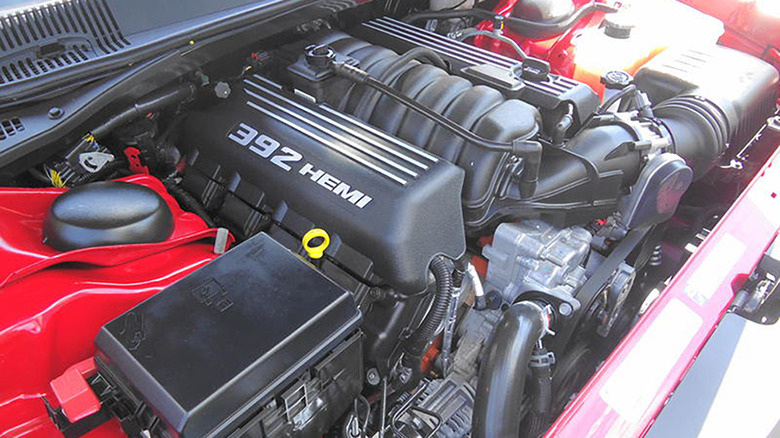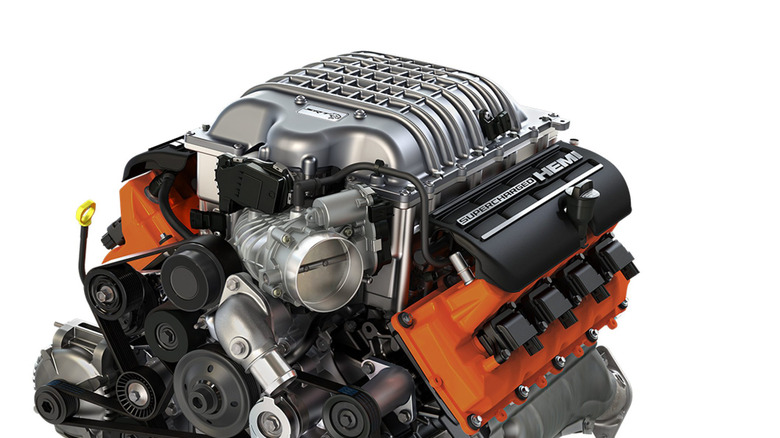The Most Common Problems With The 392 Hemi Engine According To Owner Reports
Most people associate "hemi" engines with Chrysler, who popularized them with their Hemi engine line, but the technology was first used by a Belgian manufacturer called Pipe in 1905 and placed in a Fiat race car two years later. Chrysler used the design in V12 and V16 tank and warplane engines during World War II, then installed Hemi V8 engines in its cars beginning in 1951. The engine takes its name from the hemispherical shape of the combustion chambers; this design maximizes energy transfer to the piston and allows for the installation of large valves. The Hemi went on hiatus between 1958 and 1964, but the second generation included the racing-bred 426 cubic inch version, which put out 425 horsepower (via Motor Trend).
The latest version of the third-gen Hemi has a displacement of 392 cubic inches (6.4 liters) and was first used in 2011 Dodge Challenger and Charger SRT8 muscle cars before being added as an option on Jeep Grand Cherokee and Dodge Durango SRT SUVs. It's now also used in the Jeep Wrangler Rubicon 392, Chrysler 300, and select Ram truck models. The Challenger and Charger SRT8 have been relabeled as the Challenger and Charger SRT 8 392, although the 392 designates a new appearance package only. The supercharged version of the 392 Hemi in the Charger SRT Redeye Jailbreak (that's a mouthful) makes 807 horsepower and 707 lb-ft of torque, according to Dodge.
[Featured image by Ammar Shaker via Wikimedia Commons|Cropped and scaled|CC-By 3.0]
some 392 Hemi owners have filed a lawsuit
That performance comes with some well-documented issues, though. Lemon Law Help reports that Hemi owners have filed a class-action lawsuit claiming the 392 cubic inch V8 has a design flaw in its MDS, or multi-displacement system. This mechanism responds to demand on the engine by switching between four-cylinder and eight-cylinder operation. The defect causes an audible ticking noise that can be heard when starting the engine, and pieces of metal from damaged valves can circulate through the engine, damaging engine internals, cylinder walls, and camshafts.
The suit claims that Chrysler failed to honor vehicle warranties by not replacing faulty lifters or damaged engine components. Replacing a 392 hemi engine can cost a vehicle owner about $15,000 out of pocket, and replacement engines often exhibit the same issue. Fiat Chrysler issued a STAR report — a technical service bulletin to its dealership service departments – in January 2021 reporting that "Customer complaints may include abnormal engine noise, rough idle, lack of power, [and] misfire." Technicians were instructed to check cam lobes for damage and remove the variable valve timing system's oil control valve to check for metal debris. If debris was found, the engine should be replaced.
Exhaust manifold studs can also break
The MDS has been used on various Hemi engines since 2005, but is not used on manual transmission vehicles, early Hemi-powered Ram 2500 and 3500 trucks, or performance cars like the 6.1L SRT or 6.2L Hellcat. Tuning Pro identifies three main points of failure for the MDS system: faulty solenoids, dirty oil that causes lifter rollers to make contact with camshaft lobes, and dropped valve seats due to temperature drop in deactivated cylinders.
A Hemi owner with the handle Xylander posted to the Hellcat.org online forum detailing the lifter issue. "The lifters can suffer from poor oiling," they wrote. "Thus, at low RPMs, the engine can very easily run the lifters low on lubrication. As the poorly oiled lifters hit the cam lobes, the roller may not roll over the lobe, but instead smack it."
Motorreviewer identified the lifter tick as harmless valve noise and advised Hemi owners to use the recommended 0W-40 oil and change it frequently. The site also mentioned a flaw in the exhaust manifold design that could result in heat-induced twisting that breaks the mounting studs.
The 392 hemi's pistons are a weak point
Matt Jude, a frustrated 392 Hemi owner, posted to Cummins Forum relaying issues he had with his engines and the dealership's response to his concerns. "I had the same issues with 2 motors now, and they blamed the oil changes."
A video on the Marspeed YouTube channel detailed further issues with the 392 cubic inch Hemi. The lightweight pistons don't hold up to performance boosts like forced-air induction systems or aftermarket superchargers, and these upgrades can cause damage to valves or engine cylinders. This is due to the upper piston ring land being located too close to the piston crown and the ring gap being too large. Lifter bearings can also fail and lifters can stick, wearing cam lobes to the point where valves don't open or close properly. This can cause misfiring on the affected cylinders.
Cylinder deactivation technology has also caused legal issues for General Motors. In 2021, nine plaintiffs filed suit in federal court claiming that the Active Fuel Management system in GM's 5.3 liter Ecotec V8 engine had flaws in the design and operation of valve lifters similar to the issues with the 392 Hemi.


